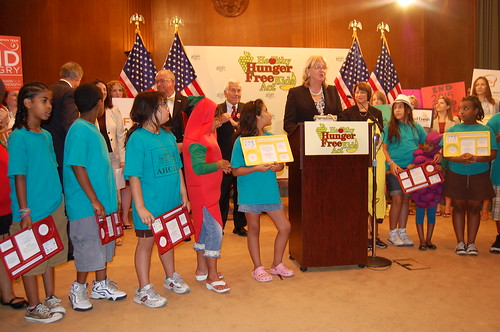
Pediatricians understand all too well the toll that obesity and malnutrition are taking on the health and well-being of our nation’s children. Pediatricians, not politicians, know what’s best for the health of our children, which is why the healthier school meals are based on the advice of pediatricians and nutrition experts. With doctors, parents, teachers and schools all working together, we can make sure our kids get the healthy start in life they deserve. --Secretary Vilsack
By: Sandra G. Hassink, MD, FAAP, President, American Academy of Pediatrics, @AAPPres
Over the years in my weight management clinic, it became clear to me that addressing each child’s medical needs, such as the need for lifestyle counseling treatment for obesity-related liver disease, type 2 diabetes, or sleep apnea, was a crucial part of my job as a pediatrician. So was caring for the whole child. That meant working to meet three of their most basic needs outside the walls of my pediatric practice: sound nutrition and healthy physical activity; stable, nurturing relationships in families, early child care settings and schools; and safe environments and communities where children live, learn and play.
The impact of healthy nutrition, healthy relationships and a healthy environment is important for every child, whether she is coming in for a check-up, battling an acute illness or dealing with a chronic disease. The earlier we start meeting these needs for all children, the better, which is why I want to focus on the critical importance of high quality, healthy and accessible nutrition. Children who are well-nourished early in life have healthier brain development, higher IQs, stronger immune systems, and better educational performance than those who are not.
Today’s children and their families are experiencing an unprecedented nutritional crisis resulting from the triple threat of obesity, food insecurity and malnutrition. Nearly 1 in 3 school-age children and adolescents has overweight and obesity, and only half of all children ages 2 to 17 meet federal diet quality standards. Children with obesity are at increased risk for high blood pressure, high cholesterol, cardiovascular disease, asthma, joint problems, and social and psychological problems, among other ailments. I’ve seen these conditions in my young patients, and they persist throughout adulthood.
The highest rates of obesity are found in people with the lowest incomes. The challenge for low-income families in today’s modern food environment may not be obtaining enough food, but rather having dependable access to high-quality food. Families with children are more likely to be food insecure, and being food insecure makes families especially vulnerable to obesity due to the additional risk factors associated with poverty, including limited resources, lack of access to healthy, affordable foods, and limited access to health care. More than 14 million children live in poverty in this country. This is why as president of the American Academy of Pediatrics (AAP), I am excited that the AAP and our more than 62,000 pediatrician members are tackling poverty and child health as a strategic priority. Children who are hungry and live in households where food is scarce—which accounts for one in five U.S. children—have difficulty learning, and are more likely to experience educational, health and behavioral problems as a result.
This is why access to healthy foods in schools is so critical to confronting this triple threat of obesity, food insecurity and malnutrition. Each day, more than thirty-two million children are served lunch through the national school lunch program. Children typically consume up to half of their daily calories in school, and for some children, the only food they eat each day comes from the federal school meals program.
The Healthy, Hunger-Free Kids Act of 2010 (HHFKA) made important updates to the nutritional quality of the foods we serve our children in schools. Our school food service personnel deserve tremendous credit for this success, with more than 92 percent of schools serving nutritious foods like fruits, vegetables and whole grains. When you’re in the midst of a crisis, and I believe we are when it comes to childhood obesity, food insecurity and hunger, you can’t keep doing what you’ve always done. We need innovative approaches to healthy eating in schools, and the school meals nutrition standards are just that.
We teach our children so many things in school. The foundational knowledge they develop as they are educated helps to set them up for success in life. We don’t expect all children to embrace algebra the first, second, or even third time we introduce it. Good nutrition is no different. It may take offering children healthy foods two, three or even four times, it may take adults modeling good habits for children, and it may take creativity from food service providers to meet children’s basic need of sound nutrition. And sound nutrition is also the key to success in the classroom; imagine trying to concentrate on a complicated algebra equation if you haven’t had enough to eat.
Our children deserve the best possible chance at success, and that means having access to healthy meals while they’re in school, connecting families to nutritional assistance programs like SNAP and WIC and encouraging schools to take advantage of the new, nationwide Community Eligibility Provision to make free meals available to children in high-poverty areas. Preserving access and minimizing barriers to enrollment in these programs for children in poverty and their families will also be key. Political ideologies should not prevent a woman who is pregnant from receiving adequate nutrition to help support a healthy baby or a child from tasting a new fruit or vegetable for the first time. Our children’s health simply cannot wait.
Good nutrition in childhood sets the stage for lifelong healthy eating. Just like we vaccinate to protect against the flu, so too can we provide children with healthy meal options to protect against obesity, food insecurity and malnutrition.



